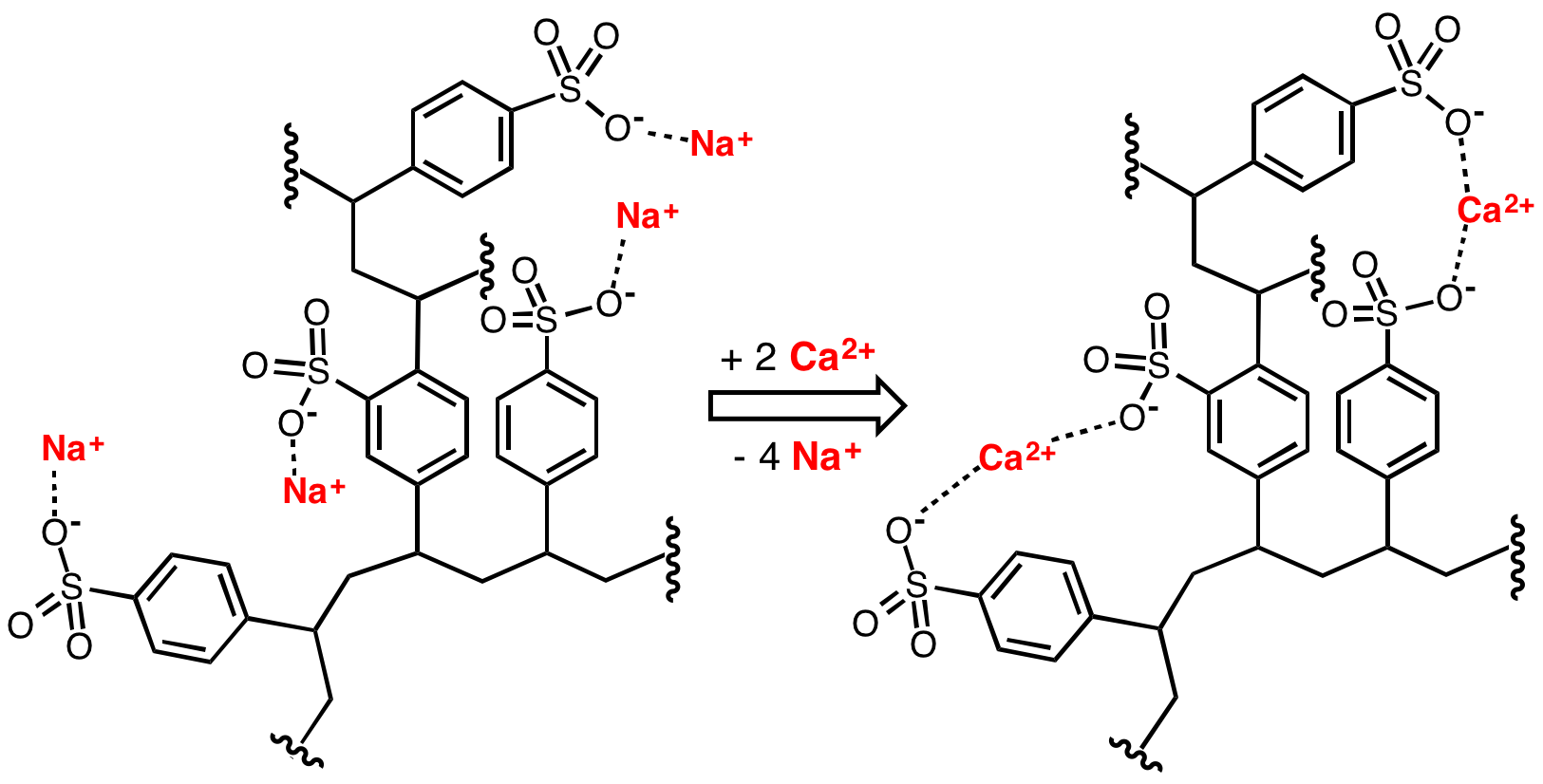|
Sorbent
A sorbent is an insoluble material that either absorbs or adsorbs liquids or gases. They are frequently used to remove pollutants and in the cleanup of chemical accidents and oil spills. Besides their uses in industry, sorbents are used in commercial products such as diapers and odor absorbents, and are researched for applications in environmental air analysis, particularly in the analysis of volatile organic compounds. The name sorbent is derived from sorption, which is itself a derivation from adsorption and absorption. Mechanism of action Sorbents collect specific liquids or gases depending on the composition of the material being used in the sorbent. Some of the most common sorbents used to clean oil spills are made from materials that are both oleophilic and hydrophobic, have high surface area through structural designs that include pores and capillaries, and draw in liquid through capillary action. Sorbents may be used to collect undesirable ions and act like a reusa ... [...More Info...] [...Related Items...] OR: [Wikipedia] [Google] [Baidu] |
Adsorption
Adsorption is the adhesion of atoms, ions or molecules from a gas, liquid or dissolved solid to a surface. This process creates a film of the ''adsorbate'' on the surface of the ''adsorbent''. This process differs from absorption, in which a fluid (the ''absorbate'') is dissolved by or permeates a liquid or solid (the ''absorbent''). While adsorption does often precede absorption, which involves the transfer of the absorbate into the volume of the absorbent material, alternatively, adsorption is distinctly a surface phenomenon, wherein the adsorbate does not penetrate through the material surface and into the bulk of the adsorbent. The term '' sorption'' encompasses both adsorption and absorption, and ''desorption'' is the reverse of sorption. Like surface tension, adsorption is a consequence of surface energy. In a bulk material, all the bonding requirements (be they ionic, covalent or metallic) of the constituent atoms of the material are fulfilled by other atoms in ... [...More Info...] [...Related Items...] OR: [Wikipedia] [Google] [Baidu] |
Diaper
A diaper (, North American English) or a nappy (British English, Australian English, Hiberno-English) is a type of underwear that allows the wearer to urinate or defecate without using a toilet, by absorbing or containing waste products to prevent soiling of outer clothing or the external environment. When diapers become wet or soiled, they require changing, generally by a second person such as a parent or caregiver. Failure to change a diaper on a sufficiently regular basis can result in skin problems around the area covered by the diaper. Diapers are made of cloth or synthetic disposable materials. Cloth diapers are composed of layers of fabric such as cotton, hemp, bamboo, microfiber, or even plastic fibers such as PLA or PU, and can be washed and reused multiple times. Disposable diapers contain absorbent chemicals and are thrown away after use. Diapers are primarily worn by infants, toddlers who are not yet toilet trained, and by children who experience bedwettin ... [...More Info...] [...Related Items...] OR: [Wikipedia] [Google] [Baidu] |
Zeolite
Zeolites are a group of several microporous, crystalline aluminosilicate minerals commonly used as commercial adsorbents and catalysts. They mainly consist of silicon, aluminium, oxygen, and have the general formula ・y where is either a metal ion or H+. The term was originally coined in 1756 by Swedish mineralogist Axel Fredrik Cronstedt, who observed that rapidly heating a material, believed to have been stilbite, produced large amounts of steam from water that had been adsorbed by the material. Based on this, he called the material ''zeolite'', from the Greek , meaning "to boil" and , meaning "stone". Zeolites occur naturally, but are also produced industrially on a large scale. , 253 unique zeolite frameworks have been identified, and over 40 naturally occurring zeolite frameworks are known. Every new zeolite structure that is obtained is examined by the International Zeolite Association Structure Commission (IZA-SC) and receives a three-letter designation. Character ... [...More Info...] [...Related Items...] OR: [Wikipedia] [Google] [Baidu] |
Absorption (chemistry)
Absorption is a physical or chemical phenomenon or a process in which atoms, molecules or ions enter the liquid or solid bulk phase of a material. This is a different process from adsorption, since molecules undergoing absorption are taken up by the volume, not by the surface (as in the case for adsorption). A more common definition is that "Absorption is a chemical or physical phenomenon in which the molecules, atoms and ions of the substance getting absorbed enter into the bulk phase (gas, liquid or solid) of the material in which it is taken up." A more general term is '' sorption'', which covers absorption, adsorption, and ion exchange. Absorption is a condition in which something takes in another substance. In many processes important in technology, the chemical absorption is used in place of the physical process, e.g., absorption of carbon dioxide by sodium hydroxide – such acid-base processes do not follow the Nernst partition law (see: solubility). For some examp ... [...More Info...] [...Related Items...] OR: [Wikipedia] [Google] [Baidu] |
Molecular Sieve
A molecular sieve is a material with pores of uniform size comparable to that of individual molecules, linking the interior of the solid to its exterior. These materials embody the molecular sieve effect, in which molecules larger than the pores are preferentially sieved, allowing for the selective adsorption of specific compounds based on their molecular size. Many kinds of materials exhibit some molecular sieves, but zeolites dominate the field. Zeolites are almost always aluminosilicates, or variants where some or all of the Si or Al centers are replaced by similarly charged elements. Sieving process The diameters of the pores that comprise molecular sieves are similar in size to small molecules. Large molecules cannot enter or be adsorbed, while smaller molecules can. As a mixture of molecules migrates through the stationary bed of porous, semi-solid substance referred to as a sieve (or matrix), the components of the highest molecular weight (which are unable to pass int ... [...More Info...] [...Related Items...] OR: [Wikipedia] [Google] [Baidu] |
Chemisorption
Chemisorption is a kind of adsorption which involves a chemical reaction between the surface and the adsorbate. New chemical bonds are generated at the adsorbent surface. Examples include macroscopic phenomena that can be very obvious, like corrosion, and subtler effects associated with heterogeneous catalysis, where the catalyst and reactants are in different phases. The strong interaction between the adsorbate and the substrate surface creates new types of electronic bonds. In contrast with chemisorption is physisorption, which leaves the chemical species of the adsorbate and surface intact. It is conventionally accepted that the energetic threshold separating the binding energy of "physisorption" from that of "chemisorption" is about 0.5 eV per adsorbed species. Due to specificity, the nature of chemisorption can greatly differ, depending on the chemical identity and the surface structural properties. The bond between the adsorbate and adsorbent in chemisorption is e ... [...More Info...] [...Related Items...] OR: [Wikipedia] [Google] [Baidu] |
Cellulose
Cellulose is an organic compound with the chemical formula, formula , a polysaccharide consisting of a linear chain of several hundred to many thousands of glycosidic bond, β(1→4) linked glucose, D-glucose units. Cellulose is an important structural component of the primary cell wall of green plants, many forms of algae and the oomycetes. Some species of bacteria secrete it to form biofilms. Cellulose is the most abundant biopolymer, organic polymer on Earth. The cellulose content of cotton fibre is 90%, that of wood is 40–50%, and that of dried hemp is approximately 57%. Cellulose is mainly used to produce paperboard and paper. Smaller quantities are converted into a wide variety of derivative products such as cellophane and rayon. Conversion of cellulose from energy crops into biofuels such as cellulosic ethanol is under development as a renewable fuel source. Cellulose for industrial use is mainly obtained from wood pulp and cotton. Cellulose is also greatly affected by ... [...More Info...] [...Related Items...] OR: [Wikipedia] [Google] [Baidu] |
Incontinence Pad
An incontinence pad is a small, impermeable multi-layered sheet with high absorbency that is used in the incontinence and health-care industries as a precaution against fecal or urinary incontinence. It is generally made of cotton if washable, or nonwoven fabric paper if disposable. Incontinence diapers (or incontinence nappies) are a common incontinence pad. Incontinence pads are usually placed in an undergarment or on a bed or chair under a person. Incontinence pads are manufactured in light and heavy grades which offer a range of absorbencies, often referred to as a 'working capacity', which refers to the true absorbency an incontinence pad offers when in use. These sorts of pads can come as panty-liners, inserts, pads or even available as replacement underwear. In the UK, chair or bed-based protective pads, known as chair pads or bed pads, are commonly used in healthcare settings where incontinence may be an issue. They are usually constructed in layers of quilted absorbent f ... [...More Info...] [...Related Items...] OR: [Wikipedia] [Google] [Baidu] |
Ion-exchange Resin
An ion-exchange resin or ion-exchange polymer is a resin or polymer that acts as a medium for ion exchange, that is also known as an ionex. It is an insoluble matrix (or support structure) normally in the form of small (0.25–1.43 mm radius) microbeads, usually white or yellowish, fabricated from an organic polymer substrate. The beads are typically porous (with a specific size distribution that will affect its properties), providing a large surface area on and inside them where the trapping of ions occurs along with the accompanying release of other ions, and thus the process is called ion exchange. There are multiple types of ion-exchange resin, that differ in composition if the target is an anion or a cation and are created based on the task they are required for. Most commercial resins are made of polystyrene sulfonateFrançois Dardel and Thomas V. Arden "Ion Exchangers" in Ullmann's Encyclopedia of Industrial Chemistry, 2008, Wiley-VCH, Weinheim. . which is followe ... [...More Info...] [...Related Items...] OR: [Wikipedia] [Google] [Baidu] |
Nonwoven Fabric
Nonwoven fabric or non-woven fabric is a fabric-like material made from staple fibre (short) and long fibres (continuous long), bonded together by chemical, mechanical, heat or solvent treatment. The term is used in the textile manufacturing industry to denote fabrics, such as felt, which are neither woven nor knitted. Some non-woven materials lack sufficient strength unless densified or reinforced by a backing. In recent years, non-wovens have become an alternative to polyurethane foam. Applications Because nonwoven fabrics do not require the intermediate step of converting fibres to yarn, they have more flexibility in materials usage. Nonwoven fabrics may be single-use, have a limited life, or be very durable. Nonwoven fabrics are sometimes designed to provide specific functions such as absorbency, liquid repellence, resilience, stretch, softness, strength, flame retardancy, washability, cushioning, thermal insulation, acoustic insulation, filtration, use as a bacterial ba ... [...More Info...] [...Related Items...] OR: [Wikipedia] [Google] [Baidu] |
Sorption
Sorption is a physical and chemical process by which one substance becomes attached to another. Specific cases of sorption are treated in the following articles: ; Absorption: "the incorporation of a substance in one state into another of a different state" (e.g., liquids being absorbed by a solid or gases being absorbed by a liquid); ; Adsorption: The physical adherence or bonding of ions and molecules onto the surface of another phase (e.g., reagents adsorbed to a solid catalyst surface); ; Ion exchange: An exchange of ions between two electrolytes or between an electrolyte solution and a complex. The reverse of sorption is desorption. Sorption rate The adsorption and absorption rate of a diluted solute in gas or liquid solution to a surface or interface can be calculated using Fick's laws of diffusion Fick's laws of diffusion describe diffusion and were first posited by Adolf Fick in 1855 on the basis of largely experimental results. They can be used to solve for the ... [...More Info...] [...Related Items...] OR: [Wikipedia] [Google] [Baidu] |
Oil Spill
An oil spill is the release of a liquid petroleum hydrocarbon into the environment, especially the marine ecosystem, due to human activity, and is a form of pollution. The term is usually given to marine oil spills, where oil is released into the ocean or coastal waters, but spills may also occur on land. Oil spills can result from the release of crude oil from oil tanker, tankers, Oil platform, offshore platforms, drilling rigs, and Oil well, wells. They may also involve spills of Oil refinery, refined petroleum products, such as gasoline and diesel fuel, as well as their by-products. Additionally, heavier fuels used by large ships, such as bunker fuel, or spills of any oily refuse or waste oil, contribute to such incidents. These spills can have severe environmental and economic consequences. Oil spills penetrate into the structure of the plumage of birds and the fur of mammals, reducing its insulating ability, and making them more vulnerable to temperature fluctuations and muc ... [...More Info...] [...Related Items...] OR: [Wikipedia] [Google] [Baidu] |





